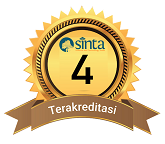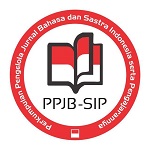Author Guidelines
DOWNLOAD
ENVIRONMENTAL WRITING STYLE
Jurnal Pendidikan Bahasa dan Sastra Indonesia METALINGUA
General requirements
- Articles received include the results of studies and research in the field of education and learning of Indonesian Language and Literature.
- Articles are written in Indonesian or English in the format determined by the METALINGUA Indonesian Language and Literature Education Journal.
- The author submits in the form of print-out as much as 3 copies with soft copies (on CD) to the editor. Articles can also be sent as METALINGUA Journal e-mail attachments to the address: metalingua.pbsi@trunojoyo.ac.id
- Articles sent to editors are articles that have never been published, evidenced by a written Statement. The statement is attached to the article.
Script Writing Standards in the Jurnal Pendidikan Bahasa dan Sastra Indonesia METALINGUA
- The article is typed in Microsoft Word with Time New Roman font size 11 points. A4 paper uses two columns, writing space 1; left border, right border, upper and lower 2.5 cm
- Figures and tables that accompany writing must be written in capital letters at the beginning. The information in the table must be placed on top of the table while in the figure below it with the letters Time New Roman 11, 1 space, while the contents of the tables and figures use Time New Roman letters size 9, 1 space. The tables and figures must be placed in the body text and meet the standards for printed out.
- Articles are written do not exceed 15 pages (including pictures and tables).
Systematics of Manuscript Writing in the Jurnal Pendidikan Bahasa dan Sastra Indonesia METALINGUA
- Systematics of writing research results are title, author's name, name, and address of the institution, e-mail address, abstract containing background, purpose, method, and results (maximum of 200 words, written using Time New Roman letters size 10 spaces 1), words- keywords (at most five words), introduction (no title), background, a brief review of literature and research objectives, methods, results and discussion, conclusions containing conclusions and suggestions, the reference list of at least 70% of the last 10 (ten) years publication and only includes referenced sources.
- The title of the article in Indonesian cannot be more than 12 words, while the title in English cannot be more than 10 words. The title is printed in capital letters in the middle, with a font size of 14 points.
- The author's name is entered without an academic degree, accompanied by the institution giving the assignment, and placed under the title of the article. In the manuscript pages written by the team, editors only relate to the main author or the author whose name is listed first. The main author must include the correspondence address or e-mail address.
- The introduction contains background, research context, results of the literature review, and research objectives. All introductory sections are presented in an integrated manner in the form of paragraphs, with a length of 15-20% of the total length of the article.
- The method section contains paragraphs of research design, data sources, data collection techniques and data analysis that are actually carried out by researchers, with a length of 10-15% of the total length of the article.
- The results and discussion section contains the results of the analysis related to the research question. Every research result must be discussed. The discussion contains the meaning of results and comparison with theories or similar research results. Length of exposure to results and discussion of 40-60% of the length of the article.
- The conclusions section contains research findings in the form of answers to the research questions or in the form of the essence of the results of the discussion.
- The reference list only contains the sources referenced, and all sources referenced must be listed in the reference list. Reference sources of at least 70% are in the form of literature in the last 10 years. The references used are primary sources in the form of research articles in journals or research reports (including thesis, thesis, and dissertation). Articles published in the Jurnal Pendidikan Bahasa dan Sastra Indonesia METALINGUA are recommended for use as a reference.
- Referrals and citations using the in note technique (last name, year). The inclusion of sources indirect quotations should be accompanied by information about the page number where the citation came from. Example: (Davis, 2003: 47)
- The list of references is arranged in the following manner, it is arranged alphabetically and chronologically.
Book:
Nurdin, Syafruddin dan Adriantoni. 2016. Kurikulum dan Pembelajaran. Depok: PT RajaGrafindo Persada.
Article collection book:
Saukah, A. & Waseso. MG. (eds.). 2002. Menulis Artikel untuk Jurnal Ilmiah (Edisi ke-4, cetakan ke-1). Malang: UM Press.
Articles in a collection of articles:
Russel, T. 1998. “An Alternative Conception: Representing Representation. Dalam P.JJ Black & A. Lucas (eds.)”, Children’s Informal Ideas in Science (hlm. 62-84). London: Routledge.
Articles in journals or magazines:
Kansil, C.L. 2002. “Orientasi Baru Penyelenggaraan Pendidikan Program Profesional dalam memenuhi Kebutuhan Dunia Industri.” Transpor, XX (4): 57-61.
Articles in Newspapers:
Pitunov, B. 13 Desember, 2002. “Sekolah Unggulan ataukah Sekolah Pengunggulan?” Majapahit Pos, hlm. 4 & 11.
Newspapers/news in the paper (without the author's name):
Jawa Pos. 22 April, 1995. Wanita Kelas Bawah Lebih Mandiri, hlm. 3.
Official document:
Pusat Pembinaan dan Pengembangan Bahasa, 1978. “Pedoman Penulisan Laporan Penelitian”. Jakarta: Depdikbud. Undang-undang Republik Indonesia Nomor 2 tentang Sistem pendidikan Nasional.1990. Jakarta: PT Armas Duta Jaya.
Book translation:
Ary, D.; Jacobs, L.C.; &Razavieh, A. 1976. Pengantar Penelitian Pendidikan. Terjemahan oleh Arief Furchan. 1982. Surabaya: Usaha Nasional.
Thesis, Dissertation, Research Report:
Kuncoro, T. 1996. “Pengembangan Kurikulum Pelatihan Magang di STM Nasional Malang Jurusan Bangunan, Program Studi Bangunan Gedung: Suatu Studi Berdasarkan Kebutuhan Dunia Usaha Jasa Konstruksi”. Tesis ini tidak diterbitkan. Malang: PPS IKIP MALANG.
Seminar papers, workshops, upgrading:
Waseso, MG. 2001.”Isi dan Format Jurnal Ilmiah”. Makalah disampaikan dalam Seminar Lokakarya Penulisan Artikel Dan Pengelolaan Jurna lIlmiah, Universitas Lambung Mangkurat, Banjarmasin, 9-11 Agustus.
Internet (individual works):
Hitchcock, S.; carr, L.; & Hall, W. 1996. A Survey of STM Online Journals, 1990-1995; The Calm before the Strom, (online), (http://journal.ecs.soton.ac.uk/survey/survey.html, diakses 12 Juni 1996).
Internet (articles in online journals):
Kumaidi, 1998, “Pengukuran Bekal Awal Belajar Dan Pengembangan Tesnya”. Jurnal Ilmu Pendidikan. (Online), jilid 5, No. 4, (http://www,malang.ac.id, diakses 20 Januari 2000)
Internet (discussion material):
Wilson, D. 20 November 1995. “Summary of Citing Internet Sites.NETTRAIN Discussion List,” (Online), (NETTRAIN@ubvm.cc.buffalo.edu, diakses 22 November 1995).
Internet (personal e-mail):
Naga, D.S. (ikip-jkt@indo.net.id). 1 Oktober 1997. Artikel untuk JIP. E-mail kepada Ali Saukah (jipp@mlg.ywcn.or.id).
- The procedures for presenting quotes, references, tables, and figures follow the provisions in the Writing Guidelines or copy the systematic writing used in the articles that have been published. Indonesian-language articles use the General Guidelines for Enhanced Indonesian Spelling and terms that are standardized by the Language Center.
- All articles are reviewed anonymously by the bestari partners (reviewers) appointed by the editorial team according to their expertise. Article writers are given the opportunity to make improvements (revisions) of the manuscript on the advice of bestari partners or editors. Certainty of loading or rejection of the manuscript will be notified in writing.
- Everything related to licensing the citation or use of computer software for making manuscripts or other matters relating to IPR done by the article writer, along with the legal consequences that may arise because of it, is the full responsibility of the article writer.
- Applicants who wish to subscribe are charged Rp. 150,000.00 for published twice.















